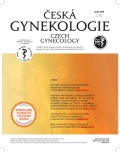Comparison of groups with medical and surgical terminations of pregnancy
Authors:
M. Pojarová; B. Sehnal; A. Jarolímková; H. Neumannová; Michal Zikán
Authors‘ workplace:
Gynekologicko-porodnická klinika, Nemocnice Na Bulovce a 1. LF UK, Praha, přednosta prof. MUDr. M. Zikán, Ph. D.
Published in:
Ceska Gynekol 2018; 83(4): 244-249
Category:
Overview
Objective: The aim of this study was to compare two cohorts of subjects who underwent termination of pregnancy up to 49 days of amenorrhoea by medical (pharmacological) termination (faUUT) and surgical instrumental termination of pregnancy (inUUT).
Design: Prospective clinical study.
Setting: Department of Gynecology and Obstetrics, Charles University in Prague, 1st Faculty of Medicine, Hospital Na Bulovce.
Methods: From August 2014 to July 2017, a total of 838 terminations of pregnancy up to 49 days of amenorrhoea were performed at our department. Altogether 474 of subjects underwent faUUT and inUUT was performed in 364 of women. We compared the anamnestic, sociodemographic, and health characteristics of women and we evaluated the efficacy, required medical interventions, medication use, the number and characteristics of complications in both groups.
Results: Women who underwent faUUT, were fewer with previous delivery (40.9% vs. 75.0%; p < 0.001), but they had more often previous artificial termination of pregnancy (27.8% vs. 19.5%; p = 0.003). The total number of outpatient visits was significant different between both cohorts, both in median (4 vs 1; p < 0.001) and arithmetic mean (3.8 vs. 1.2; p < 0.001). The usage of uterotonics was much higher in faUUT group (25.7% vs. 8.2%; p < 0.001). On the other side, the antibiotic use was similar in both groups (3.2% vs. 4.4%; p < 0.17). The surgical intervention (revisio cavi uteri instrumentalis, RCUI) required after termination of pregnancy was performed in 7.4% of faUUT cases and in 3.0% of inUUT group (p < 0.001). The failure of faUUT was found in 2 (0.4%) subjects.
Conclusion: The complications and other followed parameters were various between both groups. Medical termination of pregnancy is a safe method with some potential non life-threatening complications.
Keywords: first trimester, medical termination of pregnancy, surgical termination of pregnancy, complications, efficacy
Sources
1. AISLP. Informační systém léčivých přípravků. Dostupnéz https://www.aislp.cz/.
2. Bizjak, I., Fiala, C., Berggren, L., et al. Efficacy and safety of very early medical termination of pregnancy: a cohort study. BJOG, 2017, 124, 13, p. 1993–1999.
3. Frank, K., Gerychová, R., Janků, P., et al. Farmakologické ukončení gravidity mifepristonem a misoprostolem – zhodnocení úspěšnosti, komplikací a spokojenosti pacientek. Čes Gynek, 2015, 80, 6, s. 452–455.
4. Goldstone, P., Walker, C., Hawtin, K. Efficacy and safety of mifepristone-buccal misoprostol for early medical abortion in an Australian clinical setting. Obstet Gynaecol, 2017, 57, 3, p. 366–371.
5. Jackson, AV., Dayananda, I., Fortin, JM., et al. Can women accurately assess the outcome of medical abortion based on symptoms alone? Contraception, 2012, 85, 2, p. 192–197.
6. Kapp, N., Baldwin, MK., Rodriguez, MI. Efficacy of medical abortion prior to 6 gestational weeks: a systematic review. Contraception, 2018, 97, 2, p. 90–99.
7. Metodický pokyn ČGPS ČLS JEP. Farmakologické ukončení těhotenství do 63. dne amenorey (gestačního stáří). Čes Gynek, 2014, 78, 2, s. 240–241.
8. Mifegyne. SPC. Dostupné z http://www.sukl.cz/modules/medication/detail.php?code=0190545&tab=texts
9. Mispregnol. SPC. Dostupné z http://www.sukl.cz/modules/medication/detail.php?code=0183203&tab=texts
10. Potraty 2014–2015. Ústav zdravotnických informací a statistiky ČR 2016. Zdravotnická statistika, s. 24–26.
11. Reeves, MF., Monmaney, JA., Creinin, MD. Predictors of uterine evacuation following early medical abortion with mifepristone and misoprostol. Contraception, 2016, 93, 2, p. 119–125.
12. Sbírka zákonů České republiky. Předpis č. 273/2015 Sb., vyhláška o stanovení hodnot bodu, výše úhrad hrazených služeb a regulačních omezení pro rok 2016.
13. Sbírka zákonů České republiky. Předpis č. 350/2015 Sb., vyhláška, kterou se mění vyhláška č. 134/1998 Sb., kterou se vydává seznam zdravotních výkonů s bodovými hodnotami, ve znění pozdějších předpisů.
14. Sbírka zákonů České republiky. Předpis č. 75/1986 Sb., vyhláška, kterou se provádí zákon č. 66/1986 Sb., o umělém přerušení těhotenství.
15. Sbírka zákonů České republiky. Zákon České národní rady o umělém přerušení těhotenství, (č. 66/1986 Sb.), vyhláška (č. 75/1986 Sb.).
16. Slunská, P., Hanáček, J., Fanta, M., et al. Management umělého ukončení těhotenství Farmakologickou metodou, nepřesahuje-li těhotenství sedm týdnů v České republice. Čes Gynek, 2017, 82, 5, s. 336–344.
17. Sonalkar, S., Ogden, SN., Tran, LK., Chen, AY. Comparison of complications associated with induction by misoprostol versus dilation and evacuation for second-trimester abortion. Int J Gynaecol Obstet, 2017, 138(3), p. 272–275.
18. Šefčíková, A., Šimková, L., Dörr, A. Dva roky metody medikamentózního ukončení gravidity ve Slezské nemocnici v Opavě, úspěšnost a poznatky. Čes Gynek, 2017, 82, 3, s. 206–210.
Labels
Paediatric gynaecology Gynaecology and obstetrics Reproduction medicineArticle was published in
Czech Gynaecology

2018 Issue 4
Most read in this issue
- Late morbidity in cesarean section scar syndrome
- Implantation and diagnostics of endometrial receptivity
- Zoon vulvitis – a rare form of chronic inflammation of the vulva
- Possibilities and real meaning of assessment of ovarian reserve
